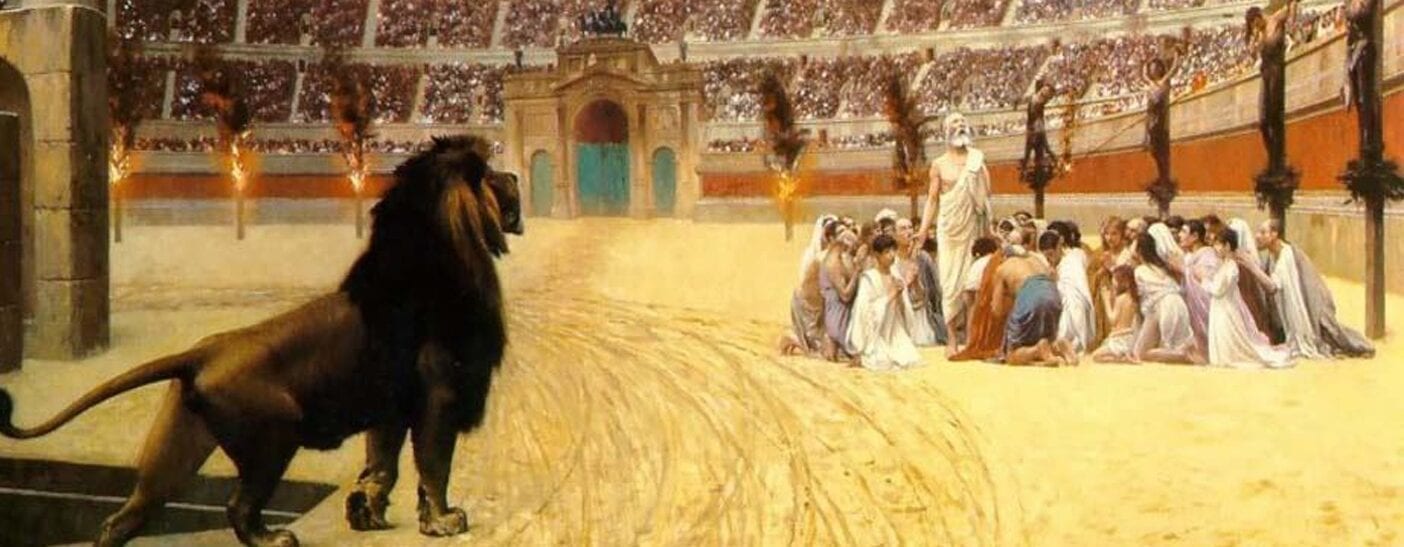Introduction
There are 5,656 New Testament manuscripts written in Greek, more than 10,000 in Latin and more than 1,000 in other languages—some dating back to the second century and available today and in reasonable condition.[1] However, the inquirer may want additional evidence from non-Christian sources. Hardly any writings have survived from early in the first century and according to E M Blaiklock in his book, Jesus Christ: Man or Myth?,[2] only a small amount of written work has been retained from the 50s and 60s. The early writings that have survived are discussed below.
Thallus
Possibly the earliest non-Christian writer to refer to Jesus, is the man Thallus, a Greek historian, who was most likely a Samaritan. About AD 55, he wrote a three volume history of the Mediterranean world from before the Trojan War to about AD 50. Thallus is first mentioned around AD 180 by Theophilus Bishop of Antioch in his Ad Autolycum. As well, his work quoted by Julius Africanus, in his A History of the World, which he wrote around AD 220. The writings of both Thallus and Africanus have been lost, but Africanus’ work is quoted by the Byzantine writer Georgius Syncellus in his Chronicle which he wrote about AD 800. The Christian historian Eusebius tells us that Thallus wrote in Greek. In his work Thallus provides details the crucifixion of Jesus but explains that the darkness that fell over the land at the time of His death[3] was not a supernatural miracle, but merely an eclipse.[4] Julius Africanus writes:
Thallus in the third book of his histories explains away this darkness as an eclipse of the sun; unreasonably, as it seems to me.
The Passover is celebrated at the full moon in the month of Nisan and Christ was crucified at Passover time. It is not possible for there to have been a solar eclipse, because the moon must pass between the sun and the earth. A full moon occurs when the moon is fully illuminated by the sun and this only happens when the earth is between the sun and the moon.
FF Bruce states in his book, The New Testament Documents: Are They Reliable?
Africanus stated his objection to the report arguing that an eclipse of the sun cannot occur during the full moon, as was the case when Jesus died at Passover time. The force of the reference to Thallus is that the circumstances of Jesus’ crucifixion were known and discussed in the Imperial City as early as the middle of the first century. The fact of Jesus’ crucifixion must have been fairly well known by that time, to the extent that unbelievers like Thallus thought it necessary to explain the matter of the darkness as a natural phenomenon.[5]
 Mara Bar Serapion
Mara Bar Serapion
Writing in the first century AD, Mara Bar Serapion, a Syrian writer, is believed to be the provider of one of the earliest non-Jewish, non-Christian references to Jesus. His letter to his son, who was in prison at the time, has been dated to sometime after AD 73. In it, he encourages his son in the pursuit of wisdom and points out that those who persecute wise men are overtaken by misfortune. To support his contention, he gives the examples of Socrates, Pythagoras and Christ.[6] F. F. Bruce cites this letter, even though it does not mention Jesus by name, as clear evidence of the historicity of Jesus.[7] The letter resides in the British Museum.
What advantage did the Athenians gain by putting Socrates to death? Famine and plague came upon them as a punishment for their crime. What advantage did the men of Samos gain for the burning of Pythagoras? In a moment their land was covered with sand. What advantage did the Jews gain from executing their wise king? It was just after that, that their kingdom was abolished. God justly avenged these three wise men: the Athenians died from hunger; the Samians were overwhelmed by the sea; the Jews, ruined and driven from their land, live in complete dispersion. But Socrates did not die for good; he lived on in the teaching of Plato. Pythagoras did not die for good, he lived on in the statue of Hera. Nor did the wise king die for good; he lived on in the teaching, which he had given.
Phlegon of Tralles (written AD 80?)
Phlegon was a first century Greek historian whose writings have been lost. However, they are referred to by Julius Africanus, who comments on Phlegon’s documentation of the darkness that came over the earth at the time of Christ’s crucifixion. As with Thallus, Phlegon puts it down to a solar eclipse, but also makes the point that it occurred during the reign of Tiberius Caesar and at the time of the Passover, and that there was a full moon, which, as stated before, makes a solar eclipse impossible.
The writings of Phlegon are also referred to by Origen in Contra Celsum, who wrote:
Phlegon mentioned the eclipse which took place during the crucifixion of the Lord Jesus Christ, and no other (eclipse) it is clear that he did not know from his source about any (similar) eclipse in previous times… And this is shown by the historical account itself of Tiberius Caesar.
From the above examples of non-biblical evidence, it is clear that none of the early writers doubted the historicity of Jesus’ existence, His crucifixion and the darkness that fell over the land.
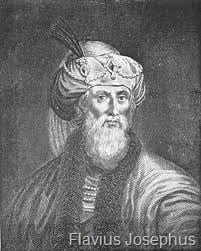 Flavius Josephus (AD 37–103)
Flavius Josephus (AD 37–103)
Josephus was the son of a priest and was reared in traditional Judaism. He got caught up in the Jewish anti-Roman resistance movement and found himself in charge of the Jotapata fortress in Galilee. Though he refused to surrender until his life was guaranteed, it was his successful prophecy that Vespasian would become emperor that brought imperial favor. He received Roman citizenship and was commissioned to write a history of the Jewish people, which he did in two compilations of writings, each consisting of many books: History of the Jewish War (against Rome) and Antiquities of the Jews.[8]
In Antiquities of the Jews, Josephus confirms the authenticity of John the Baptist and the fact that Herod had him executed:
Now some of the Jews thought that the destruction of Herod’s army came from God, and that very justly, as a punishment of what he did against John, that was called the Baptist: for Herod slew him, who was a good man, and commanded the Jews to exercise virtue, both as to righteousness and to one another, and piety towards God.[9]
Another quotation from Antiquities confirms the authenticity of Jesus’ brother James:
Festus was now dead, and Albinus was put upon the road; so he assembled the Sanhedrin of judges, and brought before them the brother of Jesus who was called Christ, whose name was James, and some others, and when he had formed an accusation against them as breakers of the law, he delivered them to be stoned.[10]
Josephus confirms the authenticity of the High Priest Annas who tried Jesus before His crucifixion:
But the younger Annas who, as we said, received the high priesthood, was of a bold disposition and exceptionally daring; he followed the party of the Sadducees who are severe in judgment above all of the Jews, as we have already shown.[11]
Josephus gives more information about Jesus in Antiquities which is consistent with scripture:
At this time there was a wise man called Jesus, and his conduct was good, and he was known to be virtuous. Many people among the Jews and the other nations became his disciples. Pilate condemned him to be crucified and to die. But those who had become his disciples did not abandon his discipleship. They reported that he had appeared to them three days after his crucifixion and that he was alive. Accordingly, he was perhaps the Messiah, concerning whom the prophets have reported wonders. And the tribe of Christians, so named after him, has not disappeared to this day.[12]
The most common form of the above verse actually says that Jesus was the Messiah and that He did appear to His disciples after returning to life on the third day. Consequently, it has been declared by many scholars to have been altered by Christians some time after the time of Josephus. The verse quoted above was found by Professor Schlomo Pines of the Hebrew University in 1972. It was written by the tenth century Melkite historian Agapius and could be the original.[13]
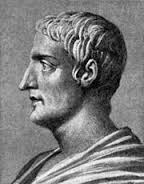 Cornelius Tacitus (circa AD 56–AD 117)
Cornelius Tacitus (circa AD 56–AD 117)
Tacitus was a senator and historian of the Roman Empire. He was governor of Asia in 112. His two major works are the Annals and the Histories, many portions of which have survived. Reporting on Emperor Nero’s decision to blame Christians for the fire that destroyed Rome, Tacitus wrote:
Consequently, to get rid of the report, Nero fastened the guilt and inflicted the most exquisite tortures on a class hated for their abominations, called Christians by the populace. Christus, from whom the name had its origin, suffered the extreme penalty during the reign of Tiberius at the hands of one of our procurators, Pontius Pilatus, and a most mischievous superstition, thus checked for the moment, again broke out not only in Judea, the first source of the evil, but even in Rome, where all things hideous and shameful from every part of the world find their center and become popular. Accordingly, an arrest was first made of all who pleaded guilty; then, upon their information, an immense multitude was convicted, not so much of the crime of firing the city, as of hatred against mankind. Mockery of every sort was added to their deaths. Covered with the skins of beasts, they were torn by dogs and perished, or were nailed to crosses, or were doomed to the flames and burnt, to serve as a nightly illumination, when daylight had expired.[14]
Below is Jean-Leon Gerome’s painting; The Christian Martyrs’ Last Prayer.
Tacitus’ statement tells us in rather unsympathetic terms that Christians derived their name from a historical person named ‘Christus’ (Latin form of the Greek Christ), and that this person suffered the extreme penalty, obviously referring to the Roman method of execution, which is crucifixion. Tacitus writes that this occurred during the reign of Tiberius and that He was sentenced by Pontius Pilate. This confirms what the Bible says about the death of Jesus.[15]
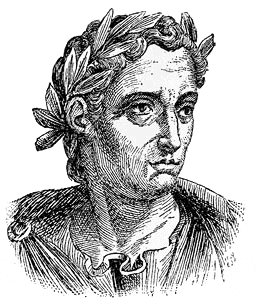 Gaius Plinius Caecilius Secundus (Pliny the Younger) (AD 61/63–ca AD 113)
Gaius Plinius Caecilius Secundus (Pliny the Younger) (AD 61/63–ca AD 113)
Pliny the Younger was the Governor of Bithynia in Asia Minor. In AD 112 he wrote a letter to the Emperor Trajan asking for advice on how to deal with Christians. He explained that he had been killing men, women, boys and girls. He was putting to death so many, he wondered if he should continue executing all he found to be Christians, because:
This contagious superstition is not confined to cities only, but has spread its infection among the neighboring villages and country.
Further, he states that he forces them to curse Christ, which genuine Christians cannot be made to do. In his letter he relates some information he has learnt about these people:
They affirmed the whole of their guilt, or their error, was, that they met on a stated day before it was light and addressed a form of prayer to Christ, as to a divinity, binding themselves to a common oath, not to do any wicked deeds, but never to commit any fraud, theft or adultery, never to falsify their word, nor deny a trust when they should be called upon to deliver it up; after which it was their custom to separate, and then reassemble to eat in common a harmless meal.[16]
This letter provides us with a number of insights into the practice and customs of early Christians. They had a fixed day for worship, they directed their worship to Christ, they adhered to a moral code which was consistent with Christ’s teaching, and they gathered to share a common meal, possibly communion. Furthermore, true believers would prefer to be executed than to curse Christ.
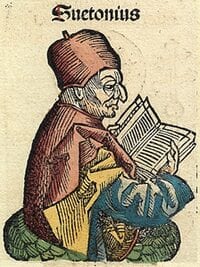 Suetonius (Gaius Suetonius Tranquillus, circa 70–after 130) [17]
Suetonius (Gaius Suetonius Tranquillus, circa 70–after 130) [17]
Suetonius was a friend of Pliny the Younger and he served under him for a period of time. He was a Roman historian and court official under Hadrian. His most important work is a surviving set of biographies on the lives of twelve successive Roman rulers from Julius Caesar to Domitian. In these writings, he makes two references to Christ:
In the Life of Claudius he wrote:
As the Jews were making constant disturbances at the instigation of Chestus [another spelling of Christus, or Christ] he [Claudius] expelled them from Rome.
In the Lives of Caesars he wrote:
Punishment by Nero was inflicted on Christians, a class of men given to a new and mischievous superstition.
In these two references Suetonius confirms that:
- There was a Christian presence in Rome and that Claudius expelled them because they were making constant disturbances. This statement is in keeping with the departure from Rome by Priscilla and Aquila in AD 49.[18]
- Christians were persecuted by Nero.
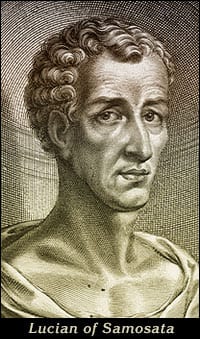 Lucian of Samosata (AD 115–ca AD 180)
Lucian of Samosata (AD 115–ca AD 180)
Lucian of Samosata was a well-known second century Greek Satirist. He claimed to have been born in Samosata, in the former kingdom of Commagene, which was absorbed by the Roman Empire and made part of Syria. He mocked the followers of Jesus for their ignorance and credulity, although he did credit Christians with a certain level of morality. He is considered important to Christians for giving insight into the historical Jesus as follows:
The Christians …worship a man to this day … the distinguished personage who introduced their novel rites, and was crucified on that account. It was impressed upon them by their original lawgiver that they were all brothers, from the moment they were converted, and deny the gods of Greece, and worship the crucified sage and live under his laws.[19]
Here Lucian tells us that the Christians worshipped a man who introduced novel rites and that He angered many of His contemporaries with His teaching to the extent that they crucified Him.
 The Babylonian Talmud
The Babylonian Talmud
The Talmuds and Tosefta are rabbinic commentaries on the Jewish scriptures and they contain references to Yeshu (Jesus). The writing most often cited as evidence of the Jesus of the Bible is the Babylonian Talmud, which was most likely compiled between AD 70 and 200.[20]
The following quotation was translated by Rabbi Dr I Epstein:
On the eve of the Passover Yeshu was hanged. For forty days before the execution took place, a herald went forth and cried, “He is going forth to be stoned because he has practiced sorcery and enticed Israel to apostasy. Anyone who can say anything in his favor let him come forward and plead on his behalf.” But since nothing was brought forward in his favor he was hanged on the eve of the Passover![21]
Here the Jewish Talmud confirms the time, the reason and the mode of Jesus’ execution. The term ‘Hanging’ was often used by the Jews to describe crucifixion. Notice Paul[22] quotes from Deuteronomy 21:23 when he refers to Christ, Cursed is everyone who hangs on a tree. But the commentators have put their slant to His execution to give the impression of a fair trial.
Summary
The aforementioned evidence of the life and death of Christ presented from non-Christian sources can be condensed as follows:
- Jesus’ death by crucifixion was confirmed by Josephus, the Babylonian Talmud, Lucian and Tacitus, and alluded to by Mara Bar Serapion. The fact that this occurred under Pontius Pilate was stated by Tacitus and Josephus and under the reign of Tiberius Caesar by Phlegon and Tacitus.
- The darkness that came during the crucifixion has been mentioned by Thallus, Phlegon and Africanus.
- His worship by Christians who followed His teaching has been confirmed by Josephus, Lucian and Suetonius. Further, Pliny states that they worshipped Christ as deity.
- The fact that He was a powerful and revered teacher was stated by the Babylonian Talmud and implied by Lucian and Pliny.
- His performance of miraculous feats was indicated by Josephus and the Talmud.
- That His followers were prepared to suffer the vilest of torture and death rather than reject Him has been confirmed by Tacitus and Pliny. That Christianity started in Judea was mentioned by Tacitus.
Only the extracts of Josephus can be open to question since they have been handed down by Christian scribes. The others were handed down through Roman and Greek scribes and are free from any allegations of tampering.
Conclusion
Non-biblical sources confirm that the man described in the Bible as Jesus of Nazareth once walked this earth and was executed by crucifixion under the governorship of Pontius Pilate, while Tiberius was Caesar, darkness came upon the area and a rapidly growing group of people which could not be contained, worshipped Him.
[1] R. E. Beacham and K. T. Bauder, Only One bible? Kregel Publications, Grand Rapids Michigan, 2,001, page 77.
[2] E. M. Blaiklock, Jesus Christ: Man or Myth? Anzea, 1983; Thomas Nelson, 1984.
[3] Matthew 27:45.
[4] wikipedia.org/wiki/Thallus, retrieved January 2011.
[5] F. F. Bruce, The New Testament Documents: Are They Reliable? Downers Grove, Intervarsity Press, 1981, page 113.
[6] wikipedia.org/wiki/Mara_Bar-Serapion, retrieved April 11, 2011
[7] F. F. Bruce, The New Testament Documents: Are They Reliable?, Downers Grove, IL, Intervarsity Press, 1981.
[8] wikipedia.org/wiki/josephus, retrieved June 15, 2011.
[9] Josephus, Antiquities of the Jews, Book 18, chapter 5, paragraph 2.
[10] Ibid, Book 20, chapter 9.
[11] Ibid, Book 20, chapter 9, paragraph 1.
[12] Ibid, Book 18, chapter. 3, paragraph 3.
[13] P. L. Maier, Eusebius The Church History, Kregel Publications, 1999, page 378.
[14] Tacitus, Annals, XV 44; see Appendix 2.
[15] The full text of this part of Tacitus’ writings is in Appendix 2 and is available online from: perseus.tufts.edu/hopper, retrieved April 11, 2011.
[16] The full text of Pliny’s letter (courtesy of Project Gutenberg) and Trajan’s reply are in Appendix 3.
[17] wikipedia.org/wiki/Suetonius, retrieved July 18, 2011.
[18] Acts 18.
[19] Lucian, The Death of Peregrine, 11–13, in The Works of Lucian of Samosata, trans. H. W. Flower, 4 volume, Oxford: Clarendon, 1949, cited by G. R. Habermas, The Historical Jesus, College Press, 1996, page 206.
[20] G. Habermas, The Historical Jesus, College Press, 1996, pages 202–203.
[21] I. Epstein, Contents of the Soncino Babylonian Talmud, The Soncino Press, London, 1935.
[22] Galatians 3:13.
